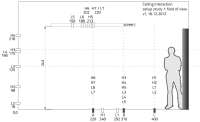Inhaltsverzeichnis
Visible Area
Our first study aimed to determine which part of the ceiling is actually visible to the user and can be used for displaying notifications (peripheral vision) and content (central(?) vision).
We conducted a study with 20 participants (X male) aged from X - X years (average: X, stddev: X). All participants had normal or corrected-to-normal vision. X participants wore glasses, X wore contact lenses. None of the participants had neck injuries or limitations. None of the participants was color-blind.
TODO: shapes/squares
The study design encompassed the following independent variables:
- height of display above eyeline (2):
- 243 cm - 125 cm (sitting) = 118 cm, „L“
- 243 cm - 175 cm (standing) = 68 cm, „H“
- inclination of eye level to horizontal plane (6):
- -49 degree (reading - will not be tested as pilot study showed that noone can see anything at the ceiling)
- -15 degree (Ruhevergenz, looking at computer screen)
- 0 degree (looking straight ahead, e.g. in conversations)
- +8 degree (looking slightly upwards - e.g. when looking at a screen or poster on the wall, peeking over one's monitor)
- +38 degree (a reasonably comfortable head inclination at least for short periods)
- + 75 degree (looking nearly straight up, head tilted back - e.g. when looking at something on the ceiling)
- + 90 degree (looking straight up)
- two directions from which the squares may appear: front and back
- two staring conditions: looking straight at the marker the whole time, and looking at the marker until one sees the square in the peripheral field of view.
- three passes for each combination of inclination (6), eye level (2), staring (2), and direction (2)
= 144 passes, → ca. 60 min per person
Marker positions
- l 1 : floor: 341 cm from wall (will not be tested)
- l 2 : wall: 4 cm from floor
- l 3 : wall: 124 cm from floor
- l 4 : wall: 188 cm from floor
- l 5 : ceiling: 748 pixels from wall-side
- l 6 : ceiling: 1480 pixels from wall-side
- l 7 : ceiling: 1287 pixels from wall-side
- h 1 : floor: 297 cm from wall (will not be tested)
- h 2 : wall: 54 cm from floor
- h 3 : wall: 175 cm from floor
- h 4 : wall: 238 cm from floor
- h 5 : ceiling: 1423 pixels from wall-side
- h 6 : ceiling: 1622 pixels from wall-side
- h 7 : ceiling: 1287 pixels from wall-side
Participant positions (from wall)
- 1: 450 cm
- 2: 450 cm
- 3: 450 cm
- 4: 450 cm
- 5: 350 cm
- 6: 300 cm
- 7: 250 cm
Variables
We measured the following dependent variables:
During each trial:
- head inclination (measured with an accelerometer attached to the user's head)
- position of target when the user first notices it
- position of target when the user is able to read the letter in the target
- whether user correctly identified the letter
- user_id, id, timestamp,
Before/after/etc:
- perceived comfort (5 point Likert scale (?)) - multiple times during session
In order to simplify calculations, we opted to use representative standard heights for the eyes in sitting and standing postures. In the sitting conditions, the chair was adjusted so that each participant's eyes were XX cm below the ceiling. In the standing conditions, smaller participants were asked to step on a set of small boxes so that their eyes were XX cm +- X cm below the ceiling.
Neck and eye inclination are not the same
Study workflow
tbd.
- do not test color - color vision bad in the outer areas
- marker: white circle with black capital letter (O, X, E, H, I, S)
- once participant notice the marker, s/he presses the button once. Once she can read the letter, s/he presses the button a second time and names the letter.
- observer notes whether the letter was recognized correctly
- each press generates audio feedback
